Citroen BERLINGO MULTISPACE 2015 2.G Owner's Manual
Manufacturer: CITROEN, Model Year: 2015, Model line: BERLINGO MULTISPACE, Model: Citroen BERLINGO MULTISPACE 2015 2.GPages: 298, PDF Size: 12.69 MB
Page 121 of 298

119
Berlingo-2-VP_en_Chap05_Securite_ed01-2015
ACTIVE CITY BRAKE
Active City Brake is a driving assistance
system that aims to avoid
a frontal collision or reduce the speed
of
an impact if the driver does not
react
sufficiently (inadequate brake
application).
This
system is designed to
improve
driving safety.
It
remains the driver's responsibility to
continuously
monitor the state of the
traffic
and to assess the distances and
relative
speeds of other vehicle.
Active
City Brake can in no
circumstances
replace the need for
vigilance
on the part of the driver. Never
look at the laser sensor
through
an optical instrument
(magnifying
glass, microscope...)
at a distance of less than
10 centimetres:
risk of eye injury.Principle
Using a laser sensor located at the top
of the windscreen, this system detects
a
vehicle running in the same direction
or
stationary ahead of your vehicle.
When
necessary, the vehicle's braking
system
is operated automatically
to avoid a collision with the vehicle
ahead.Automatic
braking occurs later
than if done by the driver
, so as
to intervene only when there is a
high
risk of collision.
Conditions for activation
Active City Brake only operates if the following conditions are met:
●
ignition
on,
●
the
vehicle is in a forward gear,
●
speed
is between about 3 and
18 mph
(5 and 30 km/h),
●
the
braking assistance systems
(ABS,
EBFD, emergency braking
assistance) are not faulty
,
●
the
trajectory control systems
(
a SR, d SC) are not deactivated or
faulty,
●
the
vehicle is not in a tight corner,
●
the
system has not been triggered
during
the previous 10 seconds.
driving safely
SaFETY
5
Page 122 of 298

120
Berlingo-2-VP_en_Chap05_Securite_ed01-2015
Operation
When your vehicle is too close to or
approaches the vehicle ahead too
quickly the system automatically
applies
the brakes to avoid a collision.
You are then alerted by the display of a
message.
The
brake lamps on your vehicle come
on
to warn other road users.
The collision can be avoided
automatically
if the difference in
speed between your vehicle and the
vehicle
ahead does not exceed 9 mph
(15 km/h).
Above
this threshold, the system will
do what is possible to avoid or reduce
the accident by lowering the speed of
impact.
The
automatic braking may bring
the
vehicle to a complete stop if the
situation
requires it.
In this case, the vehicle is held
stationary
temporarily (for about
1.5 seconds)
to allow the driver to take
back
control by pressing the brake
pedal. The
triggering of the system may cause the engine to stall, unless
the driver depresses the clutch
pedal
quickly enough during automatic
braking.
During
automatic braking, the
driver can always obtain a higher
rate of deceleration than that
controlled
by the system, by pressing
firmly
on the brake pedal.
After
an impact, the system is
automatically
put out of service: it
no
longer operates.
You
must go to a CITROËN dealer or a
qualified
workshop to have the system
made
operational again.
Operating limits
The system only detects vehicles that are stationary or moving in the same
direction
as your vehicle.
It
does not detect small vehicles
(bicycles,
motorcycles),
pedestrians
or animals, nor non-
reflective
stationary objects.
The
system is not triggered or is
interrupted
if the driver:
-
accelerates strongly
-
or turns the steering wheel
suddenly
(avoiding manoeuvre).
In
difficult weather conditions (very
heavy
rain, snow, fog, hail...),
braking
distances increase, which
can
reduce the ability of the system to
avoid
a collision.
The
driver must therefore remain
particularly
vigilant.
Never
leave accumulations of
snow
or any object projecting
above the bonnet or in front of
the
roof: this might fall into the field of
vision of the sensor and generate a
detection.
driving safely
Page 123 of 298

121
Berlingo-2-VP_en_Chap05_Securite_ed01-2015
Deactivation
The system is deactivated in the vehicle configuration menu, accessible
with
the ignition on.
Its
state is memorised when the
ignition
is switched off.
When
the system is deactivated,
a
message is displayed every
time
the ignition is switched on, to
warn
you. With the monochrome screen C
F
Press the
MENU button for access
to
the main menu.
F
Select "
Personalisation-
Configuration".
F
Select "
Define vehicle
parameters".
F
Select "
Driving assistance".
F
Select "
Automatic emergency
braking : OFF" or "Automatic
emergency braking : ON".
F
Press the "
7" or "8" button to
check
or uncheck the box and
activate
or deactivate the system
respectively
.
F
Press the "
5" or "6" button, then
the OK button to select the "OK"
box
and confirm or the Back button
to
cancel.With the touch screen tablet
F
Press the "MENU" button.
F Select the " Driving" menu.
F
In the secondary page, select
"
Vehicle settings".
F
Select "
Driving assistance" tab.
F
Check
or uncheck the "Automatic
emergency braking" box to
activate
or deactivate the system.
F
Confirm.
driving safely
SaFETY
5
Page 124 of 298

122
Berlingo-2-VP_en_Chap05_Securite_ed01-2015
Operating faults
Sensor fault
The operation of the laser sensor may
suf
fer interference from accumulations
of
dirt or misting of the windscreen.
In this case you are warned by the
display
of a message.
Use
the windscreen demisting
and regularly clean the area of the
windscreen
in front of the sensor.
Do
not stick or otherwise fix any
object
on the windscreen in front
of
the sensor. System fault
In
the event of a malfunction of the
system,
you are warned by an audible
signal
and the display of the message
"Automatic braking system fault"
.
Have
the system checked by a
CITROËN
dealer or a qualified
workshop.In
the event of an impact to the windscreen at the sensor
,
deactivate
the system and contact
a
CITROËN dealer or a qualified
workshop
to
have
your
windscreen
replaced.
Never
try to remove, adjust or test
the
sensor.
o
nly a CITR o Ë n dealer or a
qualified
workshop is able to work
on
the system.
When towing a trailer or when the
vehicle
is being towed, the system
must
be deactivated.
driving safely
Page 125 of 298
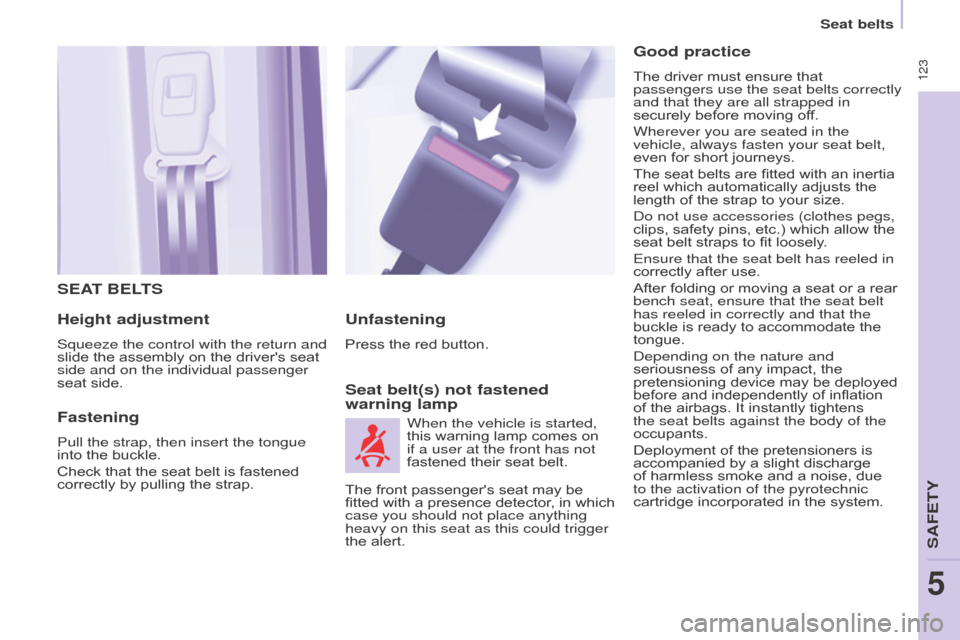
Berlingo-2-VP_en_Chap05_Securite_ed01-2015
123
SEAT BELTS
Height adjustment
Squeeze the control with the return and
slide the assembly on the driver's seat
side and on the individual passenger
seat
side.
Fastening
Pull the strap, then insert the tongue
into the buckle.
Check
that the seat belt is fastened
correctly
by pulling the strap.
Seat belt(s) not fastened
warning lamp Unfastening
Press the red button.
When the vehicle is started,
this
warning lamp comes on
if a user at the front has not
fastened
their seat belt.
Good practice
The driver must ensure that passengers use the seat belts correctly
and that they are all strapped in
securely before moving off.
Wherever you are seated in the
vehicle, always fasten your seat belt,
even
for short journeys.
The
seat belts are fitted with an inertia
reel
which automatically adjusts the
length
of the strap to your size.
d
o not use accessories (clothes pegs,
clips,
safety pins, etc.) which allow the
seat
belt straps to fit loosely.
Ensure that the seat belt has reeled in
correctly
after use.
After
folding or moving a seat or a rear
bench seat, ensure that the seat belt
has reeled in correctly and that the
buckle
is ready to accommodate the
tongue.
d
epending on the nature and
seriousness
of any impact, the
pretensioning
device may be deployed
before
and independently of inflation
of
the airbags. It instantly tightens
the seat belts against the body of the
occupants.
Deployment
of the pretensioners is
accompanied
by a slight discharge
of
harmless smoke and a noise, due
to the activation of the pyrotechnic
cartridge
incorporated in the system.
The
front
passenger's
seat
may
be
fitted
with
a
presence
detector
,
in
which
case you should not place anything
heavy on this seat as this could trigger
the
alert.
Seat belts
SaFETY
5
Page 126 of 298
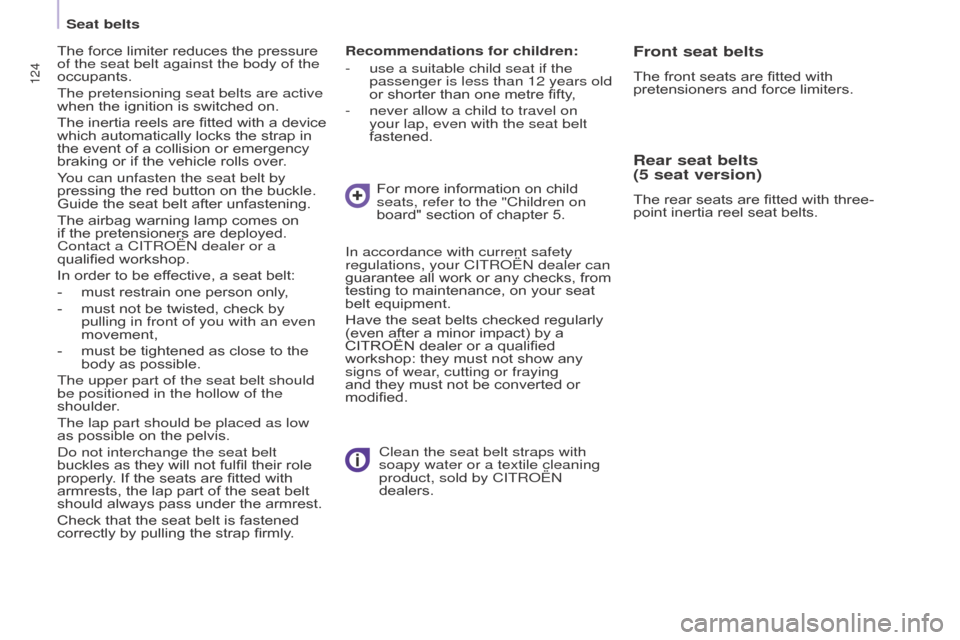
Berlingo-2-VP_en_Chap05_Securite_ed01-2015
124
Recommendations for children:
-
use a suitable child seat if the
passenger is less than 12 years old
or
shorter than one metre fifty,
-
never allow a child to travel on
your lap, even with the seat belt
fastened. For
more information on child
seats, refer to the "Children on
board"
section of chapter 5.
Clean the seat belt straps with
soapy water or a textile cleaning
product, sold by CITR
o Ë n
dealers.
In accordance with current safety
regulations, your CITR
o Ë n dealer can
guarantee
all work or any checks, from
testing
to maintenance, on your seat
belt
equipment.
Have
the seat belts checked regularly
(even
after a minor impact) by a
CITROËN
dealer or a qualified
workshop:
they must not show any
signs of wear
, cutting or fraying
and
they must not be converted or
modified.
The
force
limiter
reduces
the
pressure
of the seat belt against the body of the
occupants.
The pretensioning seat belts are active
when
the
ignition
is
switched
on.
The
inertia
reels
are
fitted
with
a
device
which
automatically
locks
the
strap
in
the
event
of
a
collision
or
emergency
braking
or
if
the
vehicle
rolls
over.
You can unfasten the seat belt by
pressing
the
red
button
on
the
buckle.
Guide
the
seat
belt
after
unfastening.
The
airbag
warning
lamp
comes
on
if
the
pretensioners
are
deployed.
Contact a CITR
o
Ë
n
dealer or a
qualified
workshop.
In
order
to
be
effective,
a
seat
belt:
-
must
restrain
one
person
only,
-
must
not
be
twisted,
check
by
pullin
g in front of you with an even
movement,
-
must
be
tightened
as
close
to
the
body
as
possible.
The upper part of the seat belt should
be positioned in the hollow of the
shoulder.
The lap part should be placed as low
as
possible
on
the
pelvis.
d
o not interchange the seat belt
buckles
as
they
will
not
fulfil
their
role
properly
.
If
the
seats
are
fitted
with
armrests,
the
lap
part
of
the
seat
belt
should
always
pass
under
the
armrest.
Check
that
the
seat
belt
is
fastened
correctly
by
pulling
the
strap
firmly.Front seat belts
The front seats are fitted with pretensioners and force limiters.
Rear seat belts
(5 seat version)
The rear seats are fitted with three-
point inertia reel seat belts.
Seat belts
Page 127 of 298

Berlingo-2-VP_en_Chap05_Securite_ed01-2015
125
Rear seat belts
(7 seat version)
In row 2
The three seats are fitted with three-
point
inertia reel seat belts.
When folding the side seats or the
seat
backs to the table position, avoid
trapping the strap of the centre seat
belt.
When handling the side seats
(removing/installin
g) or when
accessing
row 3, avoid hooking the
centre
seat belt.
Ensure that the centre seat belt is
rolled up correctly in its strengthener
on
the roof. In row 3
The
two seats are fitted with three-
point inertia reel seat belts.d
o not attach the seat belts to the
stowing
rings marked with a red cross,
represented
on the label.
Take
care to hook the seat belts
correctly on the rings provided for this
purpose.The row 3 seat belts which are not in
use can be stored to clear the load
space
and make use of the load space cover
easier.
Hook the snap hook in the location provided
on the rear pillar trim.
Seat belts
SaFETY
5
Page 128 of 298
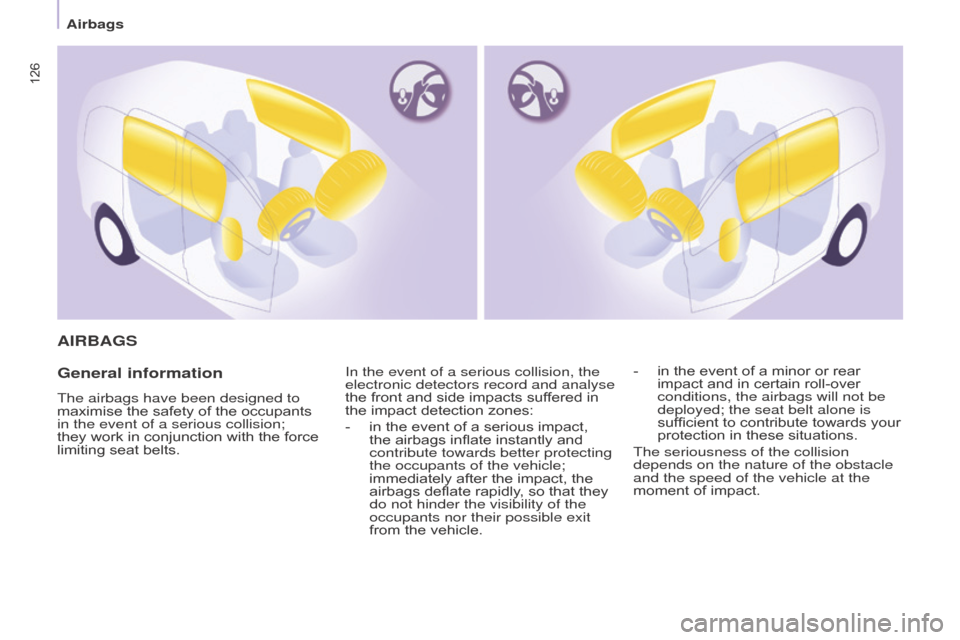
Berlingo-2-VP_en_Chap05_Securite_ed01-2015
126
AIRBAGS
General information
The airbags have been designed to
maximise the safety of the occupants
in the event of a serious collision;
they
work in conjunction with the force
limiting
seat belts. In the event of a serious collision, the
electronic detectors record and analyse
the
front and side impacts suffered in the
impact detection zones:
-
in
the event of a serious impact,
the
airbags inflate instantly and
contribute towards better protecting
the occupants of the vehicle;
immediately
after the impact, the
airbags
deflate rapidly, so that they
do not hinder the visibility of the
occupants nor their possible exit
from
the vehicle.-
in
the event of a minor or rear impact
and in certain roll-over conditions, the airbags will not be
deployed; the seat belt alone is
sufficient
to contribute towards your
protection
in these situations.
The seriousness of the collision
depends on the nature of the obstacle
and the speed of the vehicle at the
moment
of impact.
airbags
Page 129 of 298
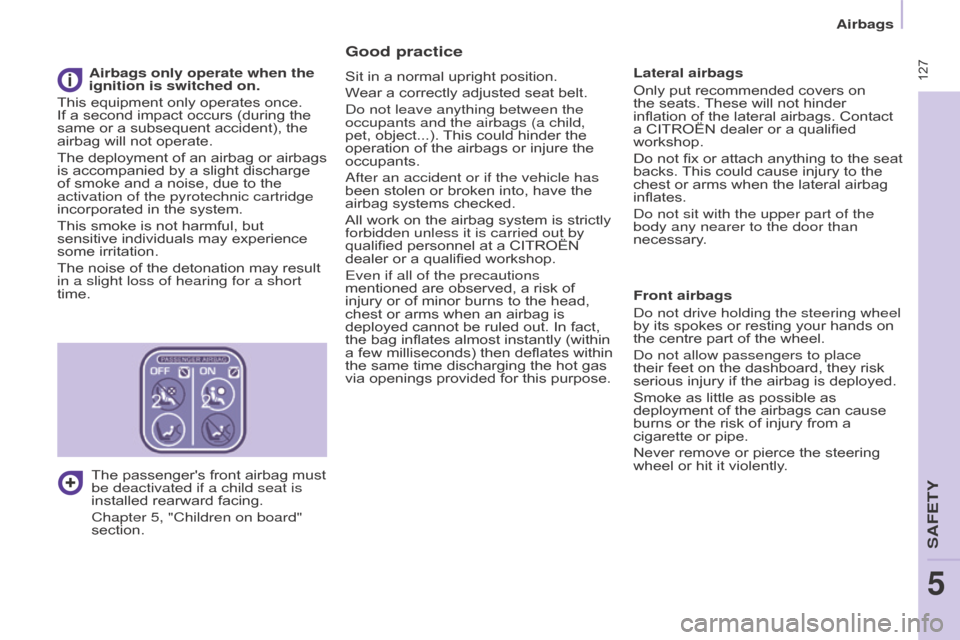
Berlingo-2-VP_en_Chap05_Securite_ed01-2015
127
Good practice
Sit in a normal upright position.
W ear a correctly adjusted seat belt.
d
o not leave anything between the
occupants and the airbags (a child,
pet,
object...).
This
could hinder the
operation
of the airbags or injure the
occupants.
a
fter an accident or if the vehicle has
been
stolen or broken into, have the
airbag
systems checked.
All
work on the airbag system is strictly
forbidden unless it is carried out by
qualified
personnel at a CITROËN
dealer
or a qualified workshop.
Even if all of the precautions
mentioned
are observed, a risk of
injury
or of minor burns to the head,
chest
or arms when an airbag is
deployed
cannot be ruled out. In fact,
the
bag inflates almost instantly (within
a
few milliseconds) then deflates within
the
same time discharging the hot gas
via
openings provided for this purpose.Lateral airbags
Only
put recommended covers on
the
seats.
These
will not hinder
inflation
of the lateral airbags. Contact
a
CITROËN dealer or a qualified
workshop.
Do
not fix or attach anything to the seat
backs.
This
could cause injury to the
chest
or arms when the lateral airbag
inflates.
d
o not sit with the upper part of the
body any nearer to the door than
necessary.
Front airbags
d
o not drive holding the steering wheel
by
its spokes or resting your hands on
the
centre part of the wheel.
d
o not allow passengers to place
their
feet on the dashboard, they risk
serious
injury if the airbag is deployed.
Smoke
as little as possible as
deployment
of the airbags can cause
burns
or the risk of injury from a
cigarette
or pipe.
Never
remove or pierce the steering
wheel
or hit it violently.
Airbags only operate when the
ignition is switched on.
This
equipment
only
operates
once.
If
a
second
impact
occurs
(during
the
same
or
a
subsequent
accident),
the
airbag
will
not
operate.
The
deployment
of
an
airbag
or
airbags
is
accompanied
by
a
slight
discharge
of
smoke
and
a
noise,
due
to
the
activation of the pyrotechnic cartridge
incorporated
in
the
system.
This
smoke
is
not
harmful,
but
sensitive
individuals
may
experience
some
irritation.
The
noise
of
the
detonation
may
result
in a slight loss of hearing for a short
time. The
passenger's
front
airbag
must
be deactivated if a child seat is
installed
rearward
facing.
Chapter 5, "Children on board"
section.
airbags
SaFETY
5
Page 130 of 298
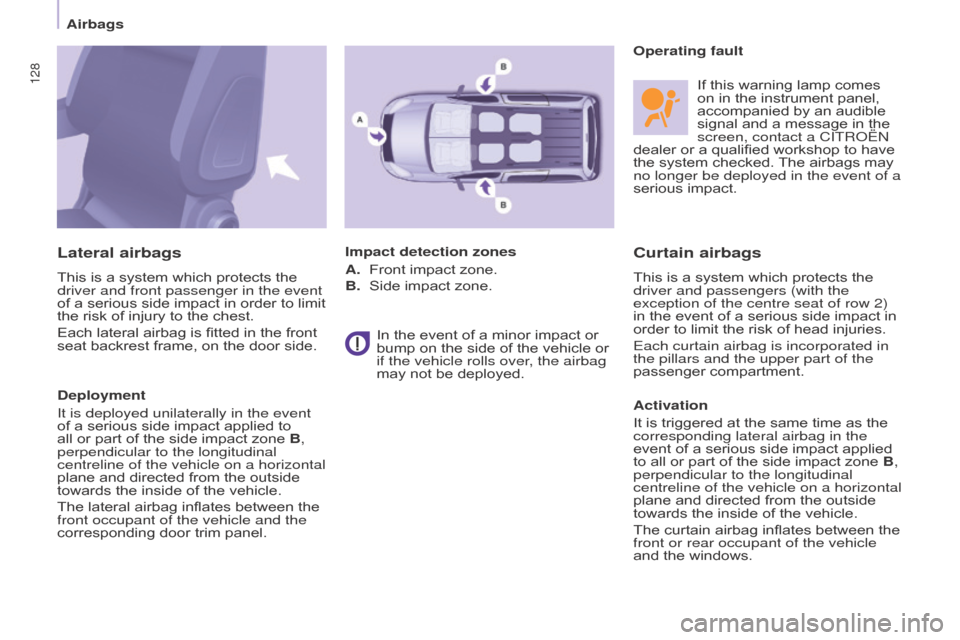
Berlingo-2-VP_en_Chap05_Securite_ed01-2015
128
Curtain airbags
This is a system which protects the driver and passengers (with the
exception of the centre seat of row 2)
in the event of a serious side impact in
order
to limit the risk of head injuries.
Each curtain airbag is incorporated in
the pillars and the upper part of the
passenger
compartment.
Activation
It
is triggered at the same time as the
corresponding lateral airbag in the
event
of a serious side impact applied
to
all or part of the side impact zone B,
perpendicular to the longitudinal
centreline of the vehicle on a horizontal
plane
and directed from the outside
towards
the inside of the vehicle.
The
curtain airbag inflates between the
front or rear occupant of the vehicle
and
the windows.
Lateral airbags
This is a system which protects the driver and front passenger in the event
of a serious side impact in order to limit
the
risk of injury to the chest.
Each
lateral airbag is fitted in the front
seat
backrest frame, on the door side.
Deployment
It is deployed unilaterally in the event
of
a serious side impact applied to
all
or part of the side impact zone B,
perpendicular to the longitudinal
centreline of the vehicle on a horizontal
plane
and directed from the outside
towards
the inside of the vehicle.
The
lateral airbag inflates between the
front occupant of the vehicle and the
corresponding
door trim panel.Impact detection zones
A.
Front impact zone.
B. Side impact zone.Operating fault
If this warning lamp comes
on
in the instrument panel,
accompanied
by an audible
signal
and a message in the
screen, contact a CITR
o Ë n
dealer or a qualified workshop to have
the
system checked.
The
airbags may
no longer be deployed in the event of a
serious
impact.
In the event of a minor impact or
bump
on the side of the vehicle or
if the vehicle rolls over
, the airbag
may
not be deployed.
airbags